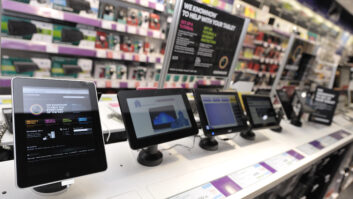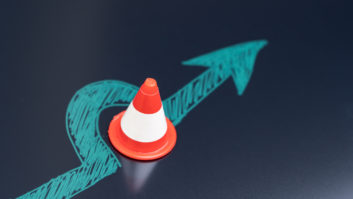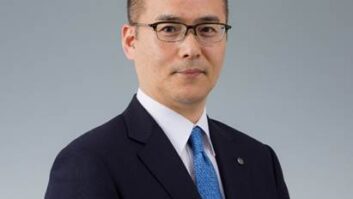It was just a coincidence that both retired Casio (U.S.) president John McDonald and Casio (Japan) co-founder and chairman Toshio Kashio were each singled out for singular honors at the 2000 International CES In Las Vegas. But it was a very fitting coincidence as their career histories and accomplishments are totally intertwined, and they were honored for very similar reasons.
McDonald was presented with a TWICE Distinguished Achievement Award at this publication’s traditional CES reception. Kashio was one of two individuals given the first-ever Lifetime Achievement Award by the Consumer Electronics Association, the industry’s trade organization and the sponsor of CES.
In the separate presentations, each of the Casio executives was cited for their contributions to the industry in developing, and even creating, the market for such ground-breaking products as pocket calculators, pocketable LCD TV sets, electronic musical instruments and, of course, electronic watches.
At the presentation of the TWICE award to McDonald, who retired from Casio last year after 25 years with the company, it was pointed out that in addition to his efforts as the head of Casio’s markets and sales effort in the U.S., he has been an unselfish contributor of his time to helping improve the industry itself.
McDonald is a past chairman of the Consumer Electronics Association, and in his ongoing role as a consultant to Casio, continues to serve as a member of the CEA board and its executive committee. He is a CEA representative to the Electronic Industries Alliance, the umbrella organization that also oversees the activities of related electronics associations, and is the chairman of the philanthropic EIA Foundation. Also, he is a member of the board of directors of the Brooklyn College Foundation, an arm of his alma mater.
As he tells it, McDonald ‘s long career with Casio is somewhat based on serendipity. As an employee of Sperry Rand in the early 1970s, McDonald was assigned to the London office where he was responsible for introducing Casio-made, but Sperry-branded, calculators to the European market. At that time he became familiar with Casio and a business acquaintance of Kashio himself.
In 1975, following his reassignment to a Sperry post in the U.S., he was called upon by Kashio and asked to spearhead the launch of Casio’s own-brand products in Europe. While working out of a London office as Casio Europe president and managing director of Casio Electronics (U.K.), McDonald made regular trips back to the U.S., particularly to be on hand for both the Summer and Winter Consumer Electronics Shows, where important corporate meetings were often held.
It was at the 1978 Winter CES, the first to be held in Las Vegas, where McDonald was surprised to be introduced by Kashio as the new president of Casio (U.S.).
Looking back on his long Casio career, McDonald said he feels the biggest single product success he experienced with the company came with the introduction of the G-Shock Watch. “It’s been around 15 years, and sales just get stronger and stronger,” he said. But what really set the watch apart was its media reception.
“When we introduced it and said it could take a full 1G of shock, NBC took us up on it and dropped one 10 stories from a hovering helicopter,” and there was no damage at all. Even more publicity was generated by a New Haven TV station that strapped one around a hockey puck and turned it over to the local pro team. “They played with the puck, and at the end, the only damage done was a broken wrist band.”
Casio parlayed the liquid crystal display expertise it gained from its calculator and watch manufacturing business into becoming one of the first companies to introduce pocket portable TVs. The industry loves them, said McDonald, “because they are one of the few TV products on which money can be made. We sell them and make money, and retailers sell them and make money.”
On a realistic note, McDonald points out the one big drawback of pocket TVs is “they still need a TV signal to function. You can’t take them into the far north woods or on long sailing trips as they basically have to be within signal reception distance. They means they have a range of 30 to 35 miles, which is fine for what they are used for.”
To a large extent, McDonald said, the pocket portable TV “has taken the place of portable radios at baseball and football games where they watch the instant replays.” Also, he said, “you can see people in the stands at a tennis match but watching baseball.”
As for product category failures as such, McDonald insists he has never had one: “There is a timing and a market for just about everything, and when an individual product doesn’t make it it’s because you either didn’t get the timing right or the promotion right. We have had some products that didn’t make it but never a whole category of product.”
Looking at some categories Casio launched, he said, “electronic cash registers, musical keyboard, handheld computers all were successful in time, but some things take longer than others to get off the ground.” The secret of the company’s success is “Casio goes from strength to strength” and has the patience for slow market development.
“There is a consumer out there for everything,” McDonald said, because the products being offered work. “The only questions is, do you get the quantities right, and do you recognize where that customer is.” As an example of the need for targeting the right customer and setting quantities, he pointed to the altimeter watch.
“We had airline and private pilots write in telling us they wanted one. We figured that if we could make a watch for divers with a depth gauge we should be able to make an altimeter version as well, and we did. But we figured the market would be very small.” Instead it turned out the demand was substantially bigger than anticipated. “Yes, pilots bought them, but we found the big market was really for mountain climbers, hikers and skiers who want to know how far up the mountain they were.”
As for why the demand from pilots, “sometime when I’m traveling by air the pilot sees my name and company on the passenger list and comes back to show me his altimeter watch. They tell me they use our watch as a check on their cockpit instruments and that our watches are as accurate as the plane’s altimeter.” However, he acknowledges the thought that the ultimate safety of the aircraft may depend on a Casio watch can be a little unnerving.
The consumer electronics universe of today is very different from the one he entered 25 years ago, said McDonald. “Everyone is going faster, the pace of business is faster, and the product live cycle is much shorter. Then a product could be good for several years, now it’s a constant hassle to keep a product on a retail shelf for longer than five months.”
In addition, “we are going from an industrial age to an information age. The Internet is akin to the introduction of Gutenberg’s printing press. It is changing the nature of information flow, and the nature of the people in our industry is changing along with that.” The new breed of executive is faster and more adaptable to quick changes in products, distribution channels and strategy, and one result of that is that they tend not to have the same clubby view of trade groups as did their predecessors.
“All I know,” he said, “is that the companies that are going to survive and the people who survive are those who can adapt to this new age.”
McDonald clearly considers himself to be among the future survivors. In addition to his current consultant contract with Casio, he has signed several other accounts and is a board member of others. As is written in his official biography, “Mr. McDonald states his vocation and avocation is work,” and it appears the industry will have McDonald as an active participant for years to come.













